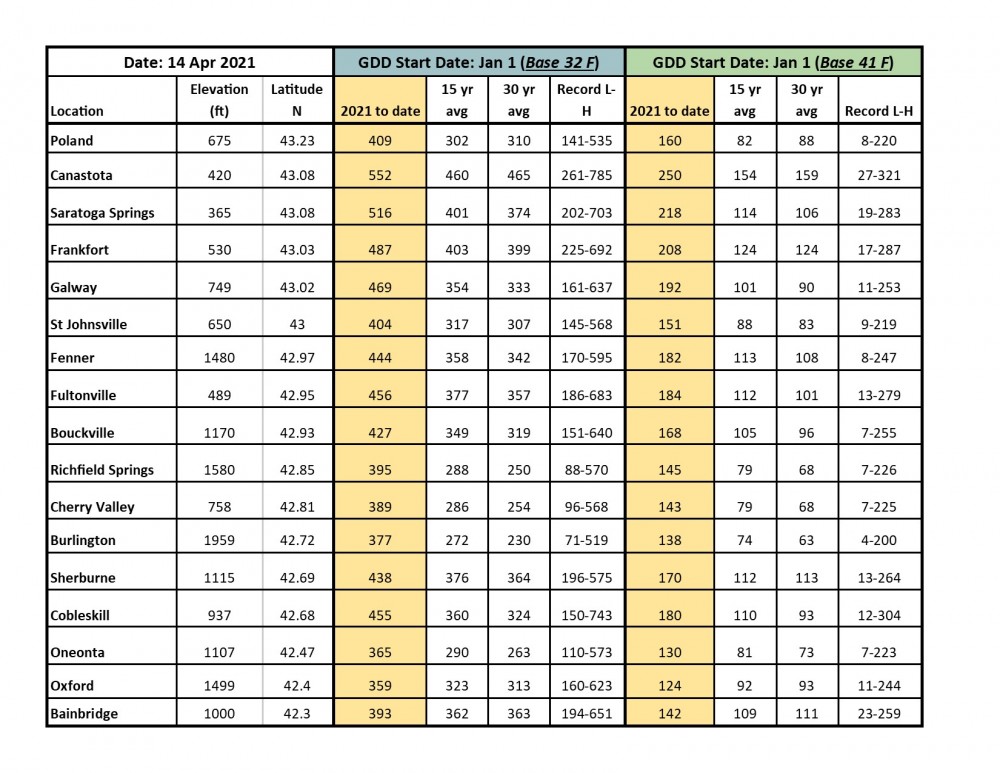GDDs April 21, 2021
Erik Smith, Area Field Crop Specialist
Central New York Dairy and Field Crops
What a difference a week makes! Soil temps were holding at or below 50, but those and GDD accumulations should be at a stand-still until Friday. Remember, GDD are calculated by taking the average daily temperature ((high + low)/2), then subtracting the 'base' temperature for the development of a particular crop or pest. During this phase of spring, we're using a base of 32 degrees F to look at grass growth, and 41 F for alfalfa growth. GDD are not especially reliable at predicting forage harvest timing in our area, but they can give you an idea of how the season is progressing. Harvest grass or top your pastures at the flag or boot stage (Feekes 8-9), which might be soon for some of us. There is some nuance for harvesting alfalfa since most of our alfalfa crops are mixed with grass (harvest pure alfalfa at 28", but 50/50 stands when alfalfa is 22"), so stay tuned for our alfalfa 1st cutting monitoring program in the coming weeks.
The entire region has been experiencing a mild water deficit this spring, but this week's precipitation will bring most of us back up toward capacity. See the Climate Smart Farming Water Deficit Calculator for more information.
Below is this week's GDD table with data current as of April 19. So far, our entire region is 25-50% above normal, with some locations double the normal accumulation. See the Climate Smart Farming Growing Degree Day website for more information.

Upcoming Events
New York State Fiber Conference
June 9, 2024
Bouckville, NY
Theme for this year: Quality Matters
Announcements
Cash Rent and Custom Harvest Survey
To date, there is limited information available about rental rates and fees for crop harvesting. Farms can use this valuable information for their farm business planning to help improve decision making and profitability.Farmers Can Join MeatSuite For Free!
MeatSuite.com is a free resource provided by Cornell University where NY meat farmers can create a farm profile and list their bulk (wholes, halves, quarters) and bundled (i.e. Grilling Bundle) meat products.Why should farmers join?
1. It's free and easy!
2. Connect with more local customers. In the past year the MeatSuite.com farm directory had 8,300 visits from New York consumers. Farm profiles get as many as 25 views per month from potential local customers. We also spotlight MeatSuite farms on social media and bring attention and purchases to farms through highlights and giveaways.
How do I join?
Farmers can visit https://www.meatsuite.com/farmers/ to create a free farm profile. You must list at least one product for your farm's profile to go live. You'll also have access to Cornell's free Meat Price Calculator, a helpful tool for pricing your meat to make a profit.
While you're on MeatSuite, check out the "Creating Consumer-Friendly Bulk Meats" publication on the log-in page. It has tips on how to create bulk meat products that are easier for first-time buyers to say "yes" to.
If you have any questions as you create your farm profile or products, we're here to help! Please email Matt LeRoux at mnl28@cornell.edu.




